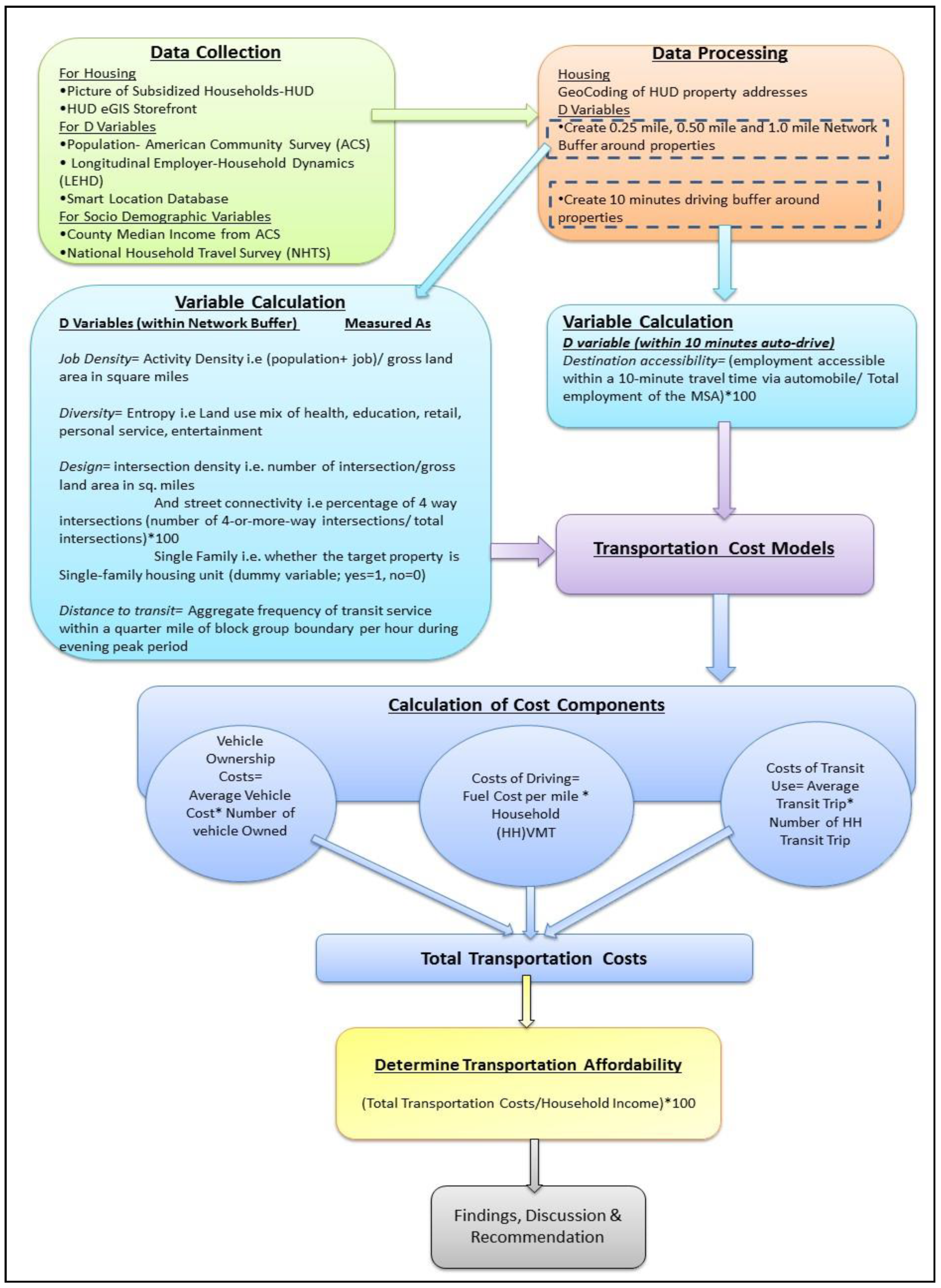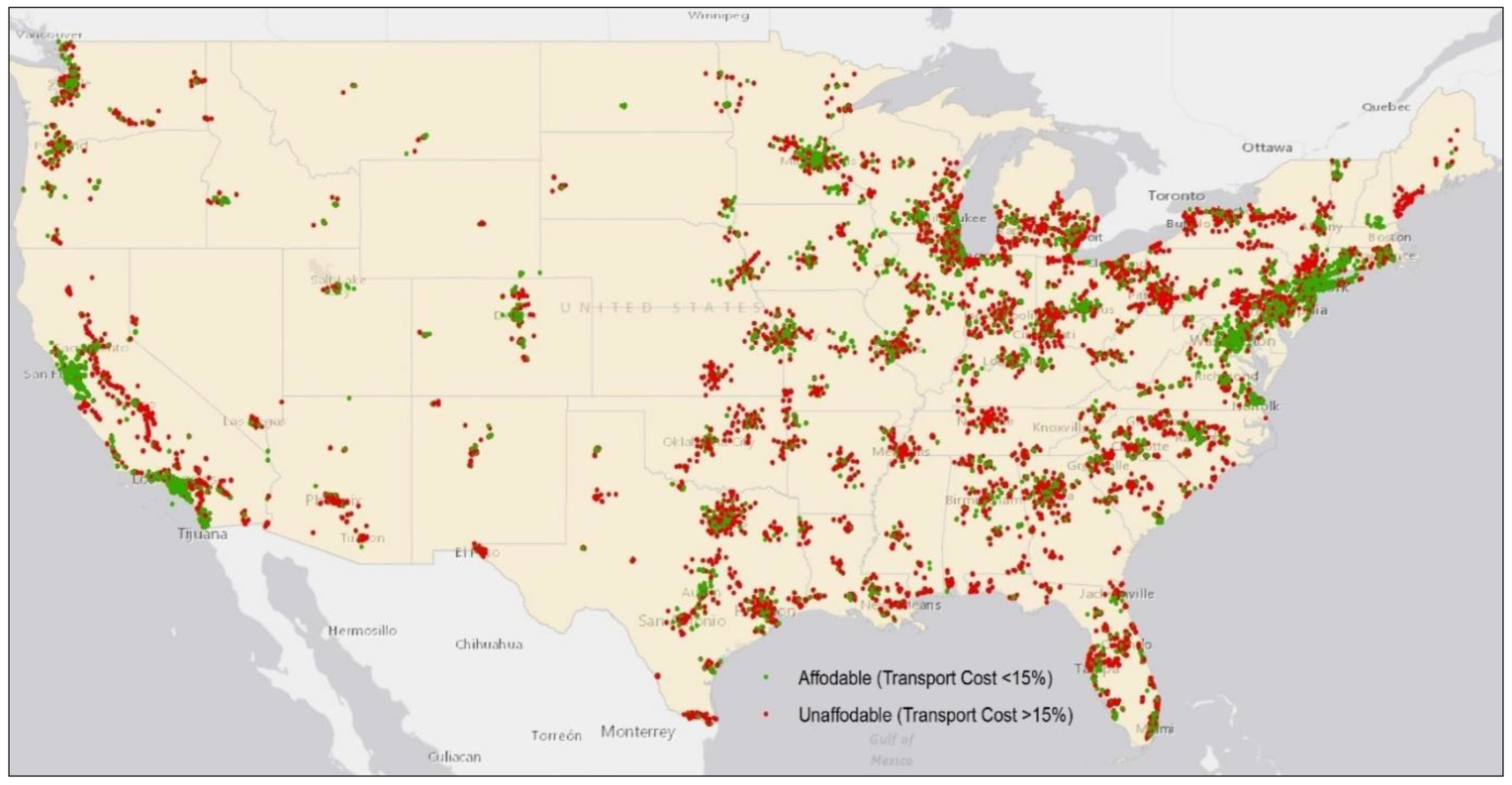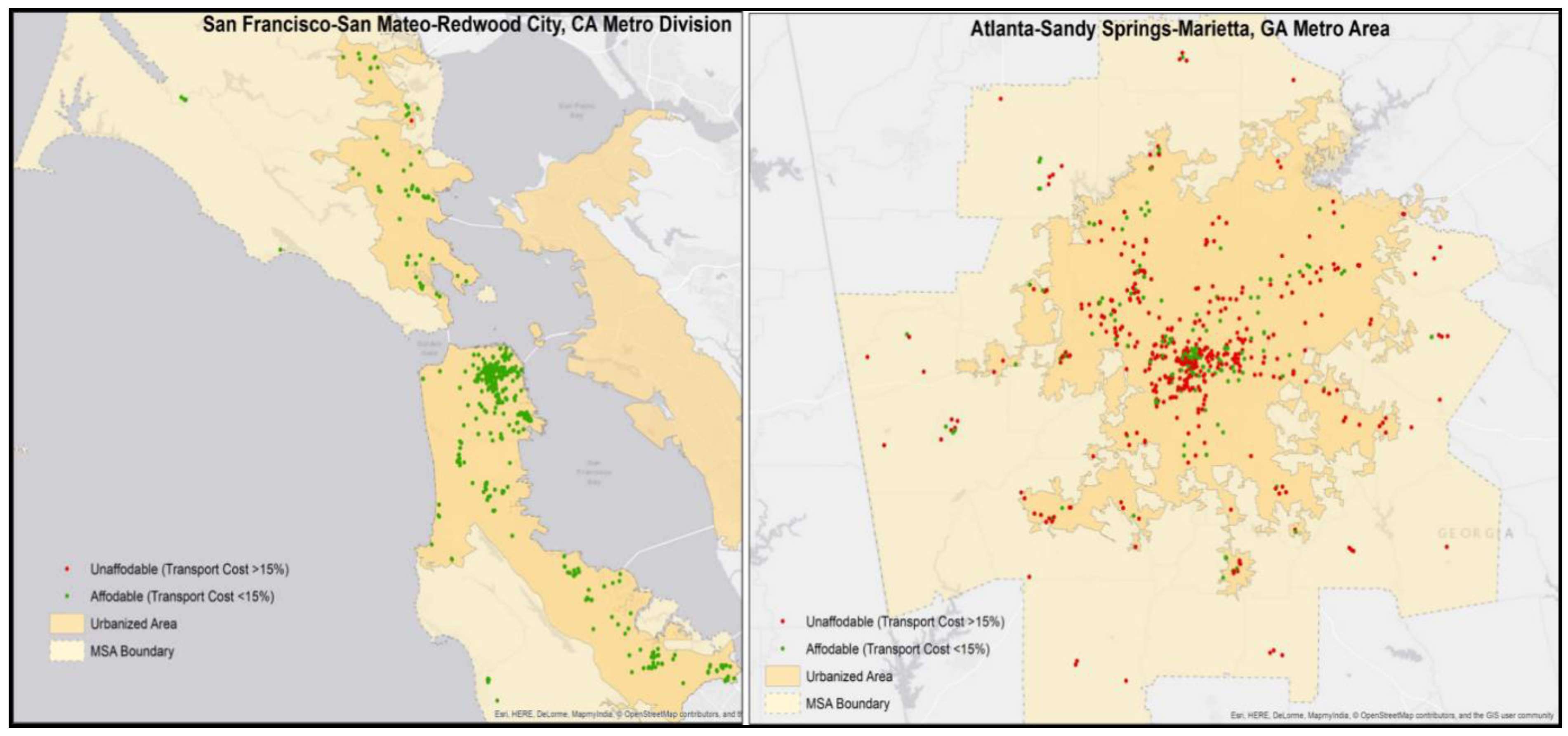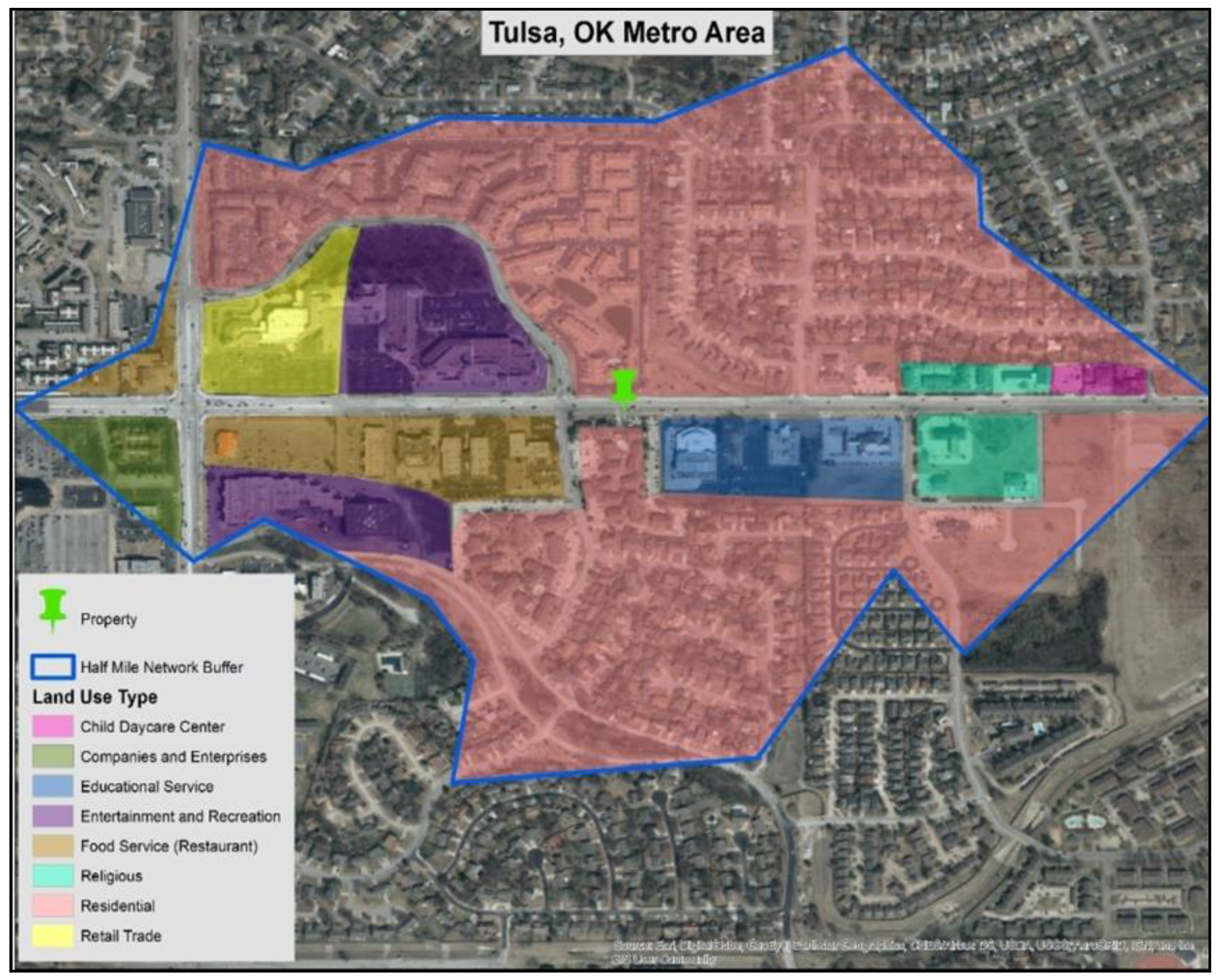A National Study on Transportation Affordability of HUD Housing Assistance Programs
Abstract
1. Introduction
2. Literature Review
2.1. Location Efficiency and Transportation Costs
2.2. Major HUD Housing Programs and Location Efficiency Considerations
3. Methods
3.1. Transportation Cost Components
3.2. Fixed Costs of Vehicle Ownership
3.3. Costs of Driving
- (a)
- Probability of a household having any VMT = EXP [1.72 + (0.23 × average household size) + (0.32 × number of employed household members) + (0.03 × average household income) + (0.85 × dummy for single family units) − (0.02 × percentage of regional employment accessible within 10 min by automobile) − (0.71 × land use mix(entropy)) − (0.003 × intersection density) − (0.01 × percentage of four-way intersections) − (0.0009 × transit frequency)]
- (b)
- Predicted VMT = exp [2.55 + (0.16 × average household size) + (0.18 × number of employed household members) + (0.007 × average household income) − (0.008 ×percentage of regional employment accessible within 10 min by automobile) − (0.005 × job population density/1000) − (0.29 × land use mix(entropy)) − (0.002 × intersection density) − (0.003 × percentage of four-way intersections) − (0.00009 × transit frequency)]*The equations are borrowed from Hamidi et al. [2].
3.4. Costs of Transit Use
- (a)
- Probability of a household having any transit trip = EXP [−2.82 + (0.16 × average household size) + (0.27 × number of employed household members) − (0.02 × average household income) − (0.79 × dummy for single family units) + (0.48 × land use mix(entropy)) + (0.003 × intersection density) + (0.01 × percentage of four-way intersections) + (0.0009 × transit frequency)]
- (b)
- Predicted number of transit trips = EXP [0.85 + (0.16×average household size) − (0.006 × average household income) + (0.17 × land use mix (entropy)]*The equations are borrowed from Hamidi et al. [2].
3.5. Total Transportation Costs and Affordability
4. Results
5. Discussions
6. Conclusions and Implications
Author Contributions
Conflicts of Interest
References
- Jewkes, M.D.; Delgadillo, L.M. Weaknesses of Housing Affordability Indices Used by Practitioners. J. Financ. Couns. Plan. 2010, 21, 43–52. [Google Scholar]
- Hamidi, S.; Ewing, R.; Renne, J. How affordable is HUD affordable housing? Hous. Policy Debate 2016, 26, 437–455. [Google Scholar] [CrossRef]
- The United States Environmental Protection Agency (EPA). Location Efficiency and Housing Type. 2011. Available online: http://www.epa.gov/sites/production/files/2014-03/documents/location_efficiency_btu.pdf (accessed on 28 May 2018).
- Newmark, G.L.; Haas, P.M.; Pappas, J.; Schwartz, M.; Kenyon, A.; Unit, M.O. Income, location efficiency, and VMT: Affordable Housing as a Climate Strategy. Center for Neighborhood Technology Working Paper, Produced for the California Housing Partnership. 2015. Available online: https://chpc.net/wp-content/uploads/2016/05/CNT-Working-Paper-revised-2015-12-18.pdf (accessed on 20 July 2018).
- Litman, T. Transportation Affordability: Evaluation and Improvement Strategies. Victoria Transport Policy Institute. 2017. Available online: http://www.vtpi.org/affordability.pdf (accessed on 28 July 2018).
- Hartell, A.M. Evaluating the Concept of Location Affordability: Recent Data on the Relationship between Transportation, Housing, and Urban Form. Hous. Policy Debate 2017, 27, 356–371. [Google Scholar] [CrossRef]
- Adkins, A.; Sanderford, A.; Pivo, G. How Location Efficient Is LIHTC? Measuring and Explaining State-Level Achievement. Hous. Policy Debate 2017, 27, 335–355. [Google Scholar] [CrossRef]
- Hamidi, S.; Jahan, J.; Moazzeni, S. Does Location Matter? Performance Analysis of the Affordable Housing Programs with Respect to Transportation Affordability in Dallas Fort Worth (DFW) Metropolis. Transp. Res. Rec. 2018. [Google Scholar] [CrossRef]
- Koschinsky, J.; Talen, E. Location Efficiency and Affordability: A National Analysis of Walkable Access and HUD-Assisted Housing. Hous. Policy Debate 2016, 26, 835–863. [Google Scholar] [CrossRef]
- Guerra, E.; Kirschen, M. Housing Plus Transportation Affordability Indices: Uses, Opportunities, and Challenges. International Transport Forum Discussion Paper. 2016. Available online: https://www.itf-oecd.org/sites/default/files/docs/housing-transport-affordability.pdf (accessed on 22 July 2018).
- The U.S. Department of Housing and Urban Development (HUD). FY 2013, Budget. Housing and Communities Built to Last. 2013. Available online: https://www.hud.gov/sites/documents/COMBBUDGET2013.PDF (accessed on 5 May 2018).
- Cornell Law School. 24 CFR—Housing and Urban Development. Available online: https://www.law.cornell.edu/cfr/text/24 (accessed on 8 June 2018).
- HUD.GOV. Code of Federal Regulations Applicable to Programs Administered by PIH. Available online: https://www.hud.gov/program_offices/public_indian_housing/regs/fedreg (accessed on June 4 2018).
- Tegeler, P.H.; Korman, H.; Reece, J.; Haberle, M. Opportunity and Location in Federally Subsidized Housing Programs; Kirwan Institute for the Study of Race and Ethnicity: Columbus, OH, USA, 2011; Available online: https://www.prrac.org/pdf/OpportunityandLocationOctober2011.pdf (accessed on 28 June 2018).
- The U.S. Government Office of Publishing. 24 CFR 941.202—Site and Neighborhood Standards. 2010. Available online: https://www.gpo.gov/fdsys/pkg/CFR-2010-title24-vol4/pdf/CFR-2010-title24-vol4-sec941-202.pdf (accessed on 27 June 2018).
- The U.S. Department of Housing and Urban Development (HUD). 569 Part 983—Project-Based Voucher (pbv) Program. Available online: https://www.hud.gov/sites/documents/983.PDF (accessed on 27 June 2018).
- The U.S. Department of Housing and Urban Development (HUD) . Programs of HUD; 2017. Available online: https://www.hud.gov/sites/dfiles/Main/documents/HUDPrograms2017.pdf (accessed on 15 June 2018).
- Cornell Law School. 24 § 891.320—Site and Neighborhood Standards. Available online: https://www.law.cornell.edu/cfr/text/24/891.320 (accessed on 23 June 2018).
- The U.S. Government Publishing Office. 24 CFR 891.125—Site and Neighborhood Standards. 2003. Available online: https://www.gpo.gov/fdsys/pkg/CFR-2003-title24-vol4/pdf/CFR-2003-title24-vol4-sec891-125.pdf (accessed on 15 June 2018).
- Cornell Law School. 24 CFR 891.125—Site and Neighborhood Standards. Available online: https://www.law.cornell.edu/cfr/text/24/891.125 (accessed on 1 July 2018).
- Section 42.—Low-Income Housing Credit. Sections 1.42-5, 1.42-15, 1.103-8. Available online: https://www.irs.gov/pub/irs-drop/rr-04-82.pdf (accessed on 1 July 2018).
- Section 42.—Low-Income Housing Credit Rev. Rul. 2003-77. Available online: https://www.irs.gov/pub/irs-drop/rr-03-77.pdf (accessed on 28 June 2018).
- The U.S. Department of Housing and Urban Development (HUD). Housing: Other Assisted Housing (Rent Supplement and Rental Housing Assistance (Section 236)). Available online: https://www.hud.gov/sites/documents/32-FY16CJ-OTHERAH.PDF (accessed on 3 July 2018).
- HOME Program Site and Neighborhood Certification. Available online: http://www.nccde.org/DocumentCenter/View/7895/HOME-Site--Neighborhood-Standards-II?bidId= (accessed on 27 June 2018).
- Lang, B.J. Location incentives in the low-income housing tax credit: Are qualified census tracts necessary? J. Hous. Econ. 2012, 21, 142–150. [Google Scholar] [CrossRef]
- Gramlich, E. Qualified Allocation Plan. National Low Income Housing Coalition. 2014. Available online: http://nlihc.org/sites/default/files/2014AG-259.pdf (accessed on 27 July 2018).
- Pennsylvania Housing Finance Agency Allocation Plan for Year 2017/2018, Low Income Housing Tax Credit Program. Available online: https://www.novoco.com/sites/default/files/atoms/files/pennsylvania_2017-2018_final_qap_2017.pdf (accessed on 20 July 2018).
- Nedwick, T.; Burnett, K. How Can the Low Income Housing Tax Credit Program Most Effectively Be Used to Provide Affordable Rental Housing Near Transit? A HUD Sustainable Communities Research Grant Report. 2014. Available online: http://www.prezcat.org/sites/default/files/How%20Can%20the%20LIHTC%20Program%20Most%20Effectively%20be%20Used%20to%20Provide%20Affordable%20Rental%20Housing%20near%20Transit.pdf (accessed on 15 July 2018).
- Ewing, R.; Cervero, R. Travel and the built environment: A meta-analysis. J. Am. Plan. Assoc. 2010, 76, 265–294. [Google Scholar] [CrossRef]
- Cervero, R.; Kockelman, K. Travel demand and the 3Ds: Density, diversity, and design. Transp. Res. Part D Transp. Environ. 1997, 2, 199–219. [Google Scholar] [CrossRef]
- Ewing, R.; Cervero, R. Travel and the built environment. Transp. Res. Rec. 2001, 1780, 87–114. [Google Scholar] [CrossRef]
- Hong, J.; Shen, Q.; Zhang, L. How do built-environment factors affect travel behavior? A spatial analysis at different geographic scales. Transportation 2014, 41, 419–440. [Google Scholar]
- Park, K.; Ewing, R.; Scheer, B.C.; Tian, G. The impacts of built environment characteristics of rail station areas on household travel behavior. Cities 2018, 74, 277–283. [Google Scholar] [CrossRef]
- Edmunds. True Cost to Own® (TCO®). Available online: https://www.edmunds.com/tco.html#about-tco-pod (accessed on 3 June 2017).
- The U.S. Department of Housing and Urban Development. Available online: https://www.huduser.gov/portal/datasets/il/fmr98/sect8.html (accessed on 15 July 2018).
- Ewing, R.; Hamidi, S. Measuring Urban Sprawl and Validating Sprawl Measures. Technical Report Prepared for the National Cancer Institute, National Institutes of Health, the Ford Foundation, and Smart Growth America. 2014. Available online: http://gis.cancer.gov/tools/urban-sprawl (accessed on 2 May 2018).
- Hamidi, S.; Ewing, R.; Preuss, I.; Dodds, A. Measuring sprawl and its impacts: An update. J. Plan. Educ. Res. 2015, 35, 35–50. [Google Scholar] [CrossRef]
- Holcombe, R.G.; Williams, D.W. Urban Sprawl and Transportation Externalities. Rev. Reg. Stud. 2012, 40, 257–272. [Google Scholar]
- Litman, T.; Steele, R. Land Use Impacts on Transport. Victoria Transport Policy Institute. 2017. Available online: http://vtpi.org/landtravel.pdf (accessed on 3 July 2018).
- Renne, J.; Tolford, L.T.; Hamidi, S.; Ewing, R. The cost and affordability paradox of transit-oriented development: A comparison of housing and transportation costs across transit-oriented development, hybrid and transit-adjacent development station typologies. Hous. Policy Debate 2016, 26, 819–834. [Google Scholar] [CrossRef]
- Renne, J.L. From transit-adjacent to transit-oriented development. Local Environ. 2009, 14, 1–15. [Google Scholar] [CrossRef]
- Galiani, S.; Murphy, A.; Pantano, J. Estimating neighborhood choice models: Lessons from a housing assistance experiment. Am. Econ. Rev. 2015, 105, 3385–3415. [Google Scholar] [CrossRef]
- Gabriel, S.; Painter, G. Why affordability matters. Reg. Sci. Urban Econ. 2018, in press. [Google Scholar]
- Van Zandt, S.S.; Mhatre, P.C. The effect of housing choice voucher households on neighborhood crime: Longitudinal evidence from Dallas. Poverty Public Policy 2013, 5, 229–249. [Google Scholar] [CrossRef]
- Goetz, E.G. From breaking down barriers to breaking up communities: The expanding spatial strategies of fair housing advocacy. Urban Aff. Rev. 51, 820–842. [CrossRef]
- Nguyen, M.T. Does affordable housing detrimentally affect property values? A review of the literature. J. Plan. Lit. 2005, 20, 15–26. [Google Scholar] [CrossRef]
- Funderburg, R.; MacDonald, H. Neighbourhood valuation effects from new construction of low-income housing tax credit projects in Iowa: A natural experiment. Urban Stud. 2010, 47, 1745–1771. [Google Scholar] [CrossRef]
- Di, W.; Murdoch, J.C. The Impact of LIHTC Program on Local Schools; Research Department, Federal Reserve Bank of Dallas: Dallas, TX, USA, 2010. [Google Scholar]
- Mattingly, K.; Morrissey, J. Housing and transport expenditure: Socio-spatial indicators of affordability in Auckland. Cities 2014, 38, 69–83. [Google Scholar] [CrossRef]
- Oppenheimer, S. Building opportunity II: Civil rights best practices in the Low Income Housing Tax Credit Program. Poverty & Race Research Action Council 2015. Available online: http://www.prrac.org/pdf/BuildingOpportunityII.pdf (accessed on 3 August 2018).
- Lucas, K. Transport and social exclusion: Where are we now? Transp. Policy 2012, 20, 105–113. [Google Scholar] [CrossRef]
- Currie, G. Gap analysis of public transport needs: Measuring spatial distribution of public transport needs and identifying gaps in the quality of public transport provision. Transp. Res. Rec. 2004, 1895, 137–146. [Google Scholar] [CrossRef]
- Currie, G. Quantifying spatial gaps in public transport supply based on social needs. J. Transp. Geogr. 2010, 18, 31–41. [Google Scholar] [CrossRef]
- Giuffrida, N.; Ignaccolo, M.; Inturri, G.; Rofè, Y.; Calabrò, G. Investigating the correlation between transportation social need and accessibility: The case of Catania. Transp. Res. Procedia 2017, 27, 816–823. [Google Scholar] [CrossRef]





| Program Name | Code or Law | Guidelines Related to Location and Access to Facilities |
|---|---|---|
| Public Housing | Title 24 CFR § 941.202: Site and neighborhood standards |
|
| HOME investment partnership | Title 24 CFR § 983.57 Site selection standards | Same as above |
| Section 8 Project-Based Rental Assistance (PBRA) | Title 24 CFR § 983.57 Site selection standards [16] | Same as above |
| Rent Supplement | Title 24 CFR § 983.57 Site selection standards [16,17] | Same as above |
| Section 811 Supportive Housing for Persons with Disabilities | Title 24 CFR § 891.125 and additional regulations from CFR § 891.320 apply | Same as above and additional requirements of CFR § 891.320 apply:
|
| Section 202 Supportive Housing for the Elderly | Title 24 CFR § 891.130 and Title 24 CFR 891.125. Site and neighborhood standards |
|
| Low-Income Housing Tax Credit | Section 42 of the Internal Revenue Code |
|
| MSA Name | Affordability | Number of Affordable and Unaffordable Properties Under Different Programs | Total Properties | % Affordability | Sprawl Index | |||||||
|---|---|---|---|---|---|---|---|---|---|---|---|---|
| PR202 | PR811 | HOME | LIHTC | PBS8 | Pub Housing | RentSup | BMS236 | |||||
| Lakeland-Winter Haven, FL | Unaffordable | 1 | 0 | 7 | 26 | 17 | 8 | 1 | 60 | 95.2 | 87.6 | |
| Affordable | 0 | 1 | 0 | 0 | 1 | 1 | 0 | 3 | 4.7 | |||
| Total | 1 | 1 | 7 | 26 | 18 | 9 | 1 | 63 | ||||
| Poughkeepsie-Newburgh-Middletown, NY | Unaffordable | 2 | 3 | 132 | 77 | 21 | 7 | 1 | 4 | 247 | 93.5 | 79.5 |
| Affordable | 0 | 0 | 9 | 8 | 0 | 0 | 0 | 0 | 17 | 6.4 | ||
| Total | 2 | 3 | 141 | 85 | 21 | 7 | 1 | 4 | 264 | |||
| Chattanooga, TN-GA | Unaffordable | 1 | 9 | 107 | 35 | 22 | 15 | 2 | 191 | 91.3 | 63.6 | |
| Affordable | 0 | 0 | 7 | 3 | 3 | 4 | 1 | 18 | 8.6 | |||
| Total | 1 | 9 | 114 | 38 | 25 | 19 | 3 | 209 | ||||
| Wichita, KS | Unaffordable | 10 | 8 | 55 | 86 | 37 | 11 | 207 | 88.8 | 91.7 | ||
| Affordable | 1 | 0 | 4 | 15 | 6 | 0 | 26 | 11.2 | ||||
| Total | 11 | 8 | 59 | 101 | 43 | 11 | 233 | |||||
| Gary, IN | Unaffordable | 2 | 8 | 55 | 51 | 22 | 18 | 156 | 88.1 | 96.7 | ||
| Affordable | 2 | 1 | 7 | 5 | 5 | 1 | 21 | 11.9 | ||||
| Total | 4 | 9 | 62 | 56 | 27 | 19 | 177 | |||||
| Nashville-Davidson--Murfreesboro--Franklin, TN | Unaffordable | 7 | 8 | 427 | 164 | 37 | 21 | 664 | 87.6 | 51.7 | ||
| Affordable | 5 | 2 | 41 | 33 | 8 | 5 | 94 | 12.4 | ||||
| Total | 12 | 10 | 468 | 197 | 45 | 26 | 758 | |||||
| Memphis, TN-MS-AR | Unaffordable | 5 | 5 | 237 | 158 | 48 | 37 | 1 | 491 | 84.4 | 70.8 | |
| Affordable | 6 | 2 | 29 | 33 | 18 | 3 | 0 | 91 | 15.6 | |||
| Total | 11 | 7 | 266 | 191 | 66 | 40 | 1 | 582 | ||||
| Columbia, SC | Unaffordable | 1 | 9 | 52 | 79 | 34 | 6 | 1 | 182 | 84.3 | 67.4 | |
| Affordable | 1 | 0 | 8 | 15 | 8 | 2 | 0 | 34 | 15.7 | |||
| Total | 2 | 9 | 60 | 94 | 42 | 8 | 1 | 216 | ||||
| Toledo, OH | Unaffordable | 9 | 15 | 147 | 91 | 47 | 6 | 315 | 83.1 | 100.9 | ||
| Affordable | 1 | 4 | 37 | 13 | 8 | 1 | 64 | 16.9 | ||||
| Total | 10 | 19 | 184 | 104 | 55 | 7 | 379 | |||||
| Pittsburgh, PA | Unaffordable | 28 | 31 | 263 | 185 | 185 | 101 | 1 | 3 | 797 | 82.0 | 95.4 |
| Affordable | 6 | 5 | 66 | 45 | 29 | 24 | 0 | 0 | 175 | 18.0 | ||
| Total | 34 | 36 | 329 | 230 | 214 | 125 | 1 | 3 | 972 | |||
| MSA Name | Affordability | Number of Affordable and Unaffordable Properties under Different Programs | Total Properties | % Affordability | Sprawl Index | |||||||
|---|---|---|---|---|---|---|---|---|---|---|---|---|
| PR202 | PR811 | HOME | LIHTC | PBS8 | Pub Housing | RentSup | BMS236 | |||||
| San Francisco-San Mateo-Redwood City, CA | Unaffordable | 0 | 0 | 0 | 1 | 0 | 0 | 0 | 0 | 1 | 0.2 | 194.3 |
| Affordable | 18 | 15 | 202 | 204 | 119 | 34 | 2 | 6 | 600 | 99.8 | ||
| Total | 18 | 15 | 202 | 205 | 119 | 34 | 2 | 6 | 601 | |||
| Bridgeport-Stamford-Norwalk, CT | Unaffordable | 0 | 0 | 0 | 0 | 1 | 0 | 0 | 1 | 0.4 | 121.6 | |
| Affordable | 6 | 4 | 122 | 70 | 62 | 37 | 1 | 302 | 99.6 | |||
| Total | 6 | 4 | 122 | 70 | 63 | 37 | 1 | 303 | ||||
| San Jose-Sunnyvale-Santa Clara, CA | Unaffordable | 0 | 0 | 3 | 5 | 2 | 0 | 0 | 0 | 10 | 2.5 | 128.7 |
| Affordable | 4 | 6 | 102 | 219 | 57 | 1 | 2 | 3 | 394 | 97.5 | ||
| Total | 4 | 6 | 105 | 224 | 59 | 1 | 2 | 3 | 404 | |||
| Oakland-Fremont-Hayward, CA | Unaffordable | 0 | 0 | 4 | 15 | 3 | 1 | 0 | 23 | 3.3 | 127.2 | |
| Affordable | 29 | 16 | 187 | 304 | 104 | 34 | 4 | 678 | 96.7 | |||
| Total | 29 | 16 | 191 | 319 | 107 | 35 | 4 | 701 | ||||
| New York-White Plains-Wayne, NY-NJ | Unaffordable | 5 | 9 | 78 | 53 | 35 | 27 | 3 | 3 | 213 | 4.8 | 203.4 |
| Affordable | 113 | 42 | 1179 | 2020 | 610 | 227 | 37 | 29 | 4257 | 95.2 | ||
| Total | 118 | 51 | 1257 | 2073 | 645 | 254 | 40 | 32 | 4470 | |||
| Santa Ana-Anaheim-Irvine, CA | Unaffordable | 0 | 17 | 7 | 2 | 26 | 5.2 | 139.7 | ||||
| Affordable | 5 | 292 | 139 | 45 | 481 | 94.8 | ||||||
| Total | 5 | 309 | 146 | 47 | 507 | |||||||
| Washington-Arlington-Alexandria, DC-VA-MD-WV | Unaffordable | 1 | 6 | 16 | 30 | 8 | 1 | 0 | 0 | 62 | 5.6 | 107.2 |
| Affordable | 17 | 40 | 281 | 436 | 183 | 83 | 4 | 5 | 1049 | 94.4 | ||
| Total | 18 | 46 | 297 | 466 | 191 | 84 | 4 | 5 | 1111 | |||
| Los Angeles-Long Beach-Glendale, CA | Unaffordable | 5 | 15 | 60 | 44 | 40 | 2 | 0 | 1 | 167 | 6.4 | 130.3 |
| Affordable | 57 | 62 | 1028 | 828 | 457 | 27 | 1 | 9 | 2469 | 93.6 | ||
| Total | 62 | 77 | 1088 | 872 | 497 | 29 | 1 | 10 | 2636 | |||
| New Haven-Milford, CT | Unaffordable | 0 | 1 | 6 | 9 | 10 | 5 | 1 | 0 | 32 | 6.9 | 116.3 |
| Affordable | 12 | 9 | 216 | 72 | 70 | 48 | 0 | 2 | 429 | 93.1 | ||
| Total | 12 | 10 | 222 | 81 | 80 | 53 | 1 | 2 | 461 | |||
| Bethesda-Rockville-Frederick, MD | Unaffordable | 1 | 4 | 18 | 3 | 2 | 0 | 1 | 0 | 29 | 8.9 | 114.7 |
| Affordable | 2 | 29 | 107 | 89 | 42 | 21 | 3 | 4 | 297 | 91.1 | ||
| Total | 3 | 33 | 125 | 92 | 44 | 21 | 4 | 4 | 326 | |||
© 2019 by the authors. Licensee MDPI, Basel, Switzerland. This article is an open access article distributed under the terms and conditions of the Creative Commons Attribution (CC BY) license (http://creativecommons.org/licenses/by/4.0/).
Share and Cite
Jahan, J.; Hamidi, S. A National Study on Transportation Affordability of HUD Housing Assistance Programs. Sustainability 2020, 12, 123. https://doi.org/10.3390/su12010123
Jahan J, Hamidi S. A National Study on Transportation Affordability of HUD Housing Assistance Programs. Sustainability. 2020; 12(1):123. https://doi.org/10.3390/su12010123
Chicago/Turabian StyleJahan, Jinat, and Shima Hamidi. 2020. "A National Study on Transportation Affordability of HUD Housing Assistance Programs" Sustainability 12, no. 1: 123. https://doi.org/10.3390/su12010123
APA StyleJahan, J., & Hamidi, S. (2020). A National Study on Transportation Affordability of HUD Housing Assistance Programs. Sustainability, 12(1), 123. https://doi.org/10.3390/su12010123





